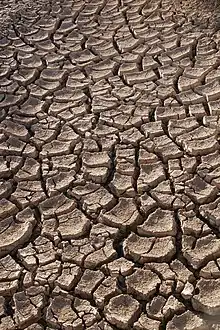Takir (suelo)
Takir (o takyr) (ruso: такыр, originario del kazajo u otra lengua turca) que significa "liso, uniforme o desnudo", es un tipo de relieve que se presenta en los desiertos de Asia Central, similar a un salar en el suroeste de Estados Unidos.[1][2] Se forma en áreas deprimidas con un suelo arcilloso pesado, que queda sumergido en agua poco profunda después de las lluvias estacionales.[3] Cuando el agua se evapora, se forma una costra seca con fisuras en la superficie. Suele estar colonizado por cianobacterias filamentosas.

Takyr (playa) en el desierto de Sonora (EE.UU.)
Referencias
- "Kyrgyzstan" National Encyclopedia , Volume: 6. Asanov, chief editor of Y. A. K 97. K .: State and the Center, 2014. 816 pages, Fig. ISBN 978 9967-14-117-9
- Gvozdetsky N. A., Mikhailov N. I. Takyry: Deserts of the Turan Lowland and Balkhash in Physical Geography of the USSR. Asian part. Third edition, revised and updated. Moscow. Thought. 1978
- Gerasimov I.P. On “takhirs” and the process of takyr formation: (Materials for the knowledge of the desert-steppe soil-forming process) in Soil Science. 1931. No. 4. S. 5-13.
Bibliografía
- Jayne Belnap, Otto Ludwig Lange. "Biological Soil Crusts: Structure, Function, and Management". Springer, 2001, ISBN 3-540-43757-6. Page 90, Chapter 7.5, "Central Asia Takyr".
- Gerasimov I.P. On "takhirs", their genetic essence and the process of takyproerazovaniya // Soil Science. 1933. No. 5. P. 401-403.
- Uspanov, U. U., Genesis and Reclamation of takyr. M .; L .: Publishing House of the Academy of Sciences of the USSR, 1940. 116 p. (Works of the Soil Institute; T. 19. Issue 1).
Este artículo ha sido escrito por Wikipedia. El texto está disponible bajo la licencia Creative Commons - Atribución - CompartirIgual. Pueden aplicarse cláusulas adicionales a los archivos multimedia.